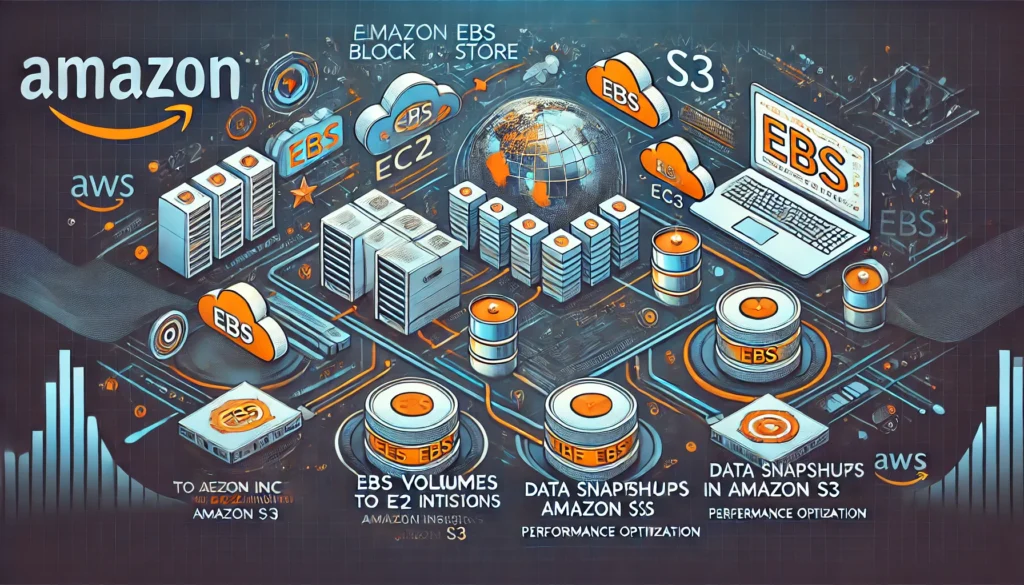1. Introduction to AWS Amazon EBS
Amazon Elastic Block Store (Amazon EBS) is a high-performance, scalable, and durable block storage service provided by AWS. It is designed to work seamlessly with Amazon EC2 instances, providing low-latency, persistent storage for applications requiring consistent performance.
AWS EBS is commonly used for databases, file systems, big data processing, and backup solutions, offering different volume types optimized for performance, durability, and cost-effectiveness.
2. Key Features of Amazon EBS
a. High Performance & Low Latency
- Provides high-speed storage with low-latency read/write operations.
- Supports up to 64,000 IOPS (Input/Output Operations Per Second) with certain volume types.
b. Persistent & Durable Storage
- Unlike Amazon EC2 instance store, EBS persists data even after an instance stops or is terminated.
- Designed for 99.999% availability per volume.
c. Multiple Volume Types for Different Workloads
AWS EBS provides different volume types based on performance and cost:
| Volume Type | Best For | Performance |
|---|---|---|
| gp3 (General Purpose SSD) | Most workloads, databases, dev/test environments | Up to 16,000 IOPS, 1,000 MB/s throughput |
| gp2 (General Purpose SSD) | Balanced performance & cost | Baseline 3 IOPS per GB, burstable |
| io2 (Provisioned IOPS SSD) | High-performance databases, low-latency workloads | Up to 64,000 IOPS, 4,000 MB/s throughput |
| st1 (Throughput Optimized HDD) | Big data, log processing, streaming workloads | Optimized for sequential workloads |
| sc1 (Cold HDD) | Archival storage, infrequently accessed data | Low-cost, high-latency |
d. Snapshots & Backup Integration
- Supports point-in-time snapshots for backups and disaster recovery.
- Snapshots can be stored in Amazon S3 for long-term retention.
e. Encryption & Security
- Data is encrypted by default using AWS KMS (Key Management Service).
- Supports IAM roles and access controls to restrict unauthorized access.
f. Auto Scaling & Elasticity
- Volumes can be resized dynamically without downtime.
- Integration with AWS Auto Scaling for flexible storage expansion.

3. How Amazon EBS Works
1️⃣ Create an EBS Volume – Choose volume type and size based on workload.
2️⃣ Attach to an EC2 Instance – Assign the volume to an EC2 instance.
3️⃣ Format & Mount the Volume – Prepare storage for file system operations.
4️⃣ Manage & Scale Storage – Resize volumes and optimize performance dynamically.
5️⃣ Create Snapshots & Backup – Automate backups using Amazon S3 snapshots.
4. Use Cases of Amazon EBS
a. High-Performance Databases
- Supports MySQL, PostgreSQL, Oracle, SQL Server, and NoSQL databases.
- Provides low-latency storage for database workloads.
b. Enterprise Applications & File Systems
- Persistent storage for ERP, CRM, and enterprise web applications.
- Used with Amazon FSx, Lustre, and EFS for file storage.
c. Big Data & Analytics
- Supports high-throughput workloads like Apache Spark, Hadoop, and EMR.
- Optimized for real-time analytics and streaming data pipelines.
d. Machine Learning & AI Workloads
- High-speed storage for training deep learning models.
- Supports large-scale data preprocessing and model inference.
e. Backup & Disaster Recovery
- Automated snapshots provide protection against data loss.
- Snapshots can be restored across AWS regions for redundancy.
5. Amazon EBS vs. Other AWS Storage Services
| Feature | Amazon EBS | Amazon S3 | Amazon EFS | AWS Glacier |
|---|---|---|---|---|
| Storage Type | Block Storage | Object Storage | File System | Archival Storage |
| Best Use Case | Persistent storage for EC2 | Scalable web storage, backups | Shared file storage for multiple EC2 instances | Long-term data retention |
| Performance | Low-latency, high-speed | High scalability | Scalable, distributed | Low-cost, high-latency |
| Persistence | Data persists after EC2 stops | Object-based, not tied to compute | Persistent, shared access | Archive storage for years |
| Pricing Model | Pay-per-GB & IOPS | Pay-per-GB & API requests | Pay-per-GB & throughput | Pay-per-GB & retrieval fees |
6. Amazon EBS Pricing
Amazon EBS follows a pay-as-you-go pricing model, based on:
- Volume Type & Size – Charged per GB-month based on selected storage type.
- Provisioned IOPS – Additional costs for high-performance io2 volumes.
- Snapshot Storage – Snapshots stored in Amazon S3 incur additional charges.
- Data Transfer – No fees for EBS within the same availability zone; cross-region snapshots may have transfer costs.
Example Cost Calculation:
- 100GB gp3 EBS volume (~$8.00/month)
- 100GB snapshot stored in Amazon S3 (~$5.00/month)
Use the AWS Pricing Calculator to estimate your specific costs.
7. Best Practices for Using Amazon EBS
✅ Choose the Right Volume Type – Match performance needs with gp3, io2, or HDD options.
✅ Enable EBS Snapshots – Protect data with automated backups and versioning.
✅ Use Encryption – Apply AWS KMS encryption for secure data storage.
✅ Monitor Performance – Use AWS CloudWatch for IOPS and latency tracking.
✅ Optimize Costs – Move infrequently accessed data to lower-cost storage tiers.
8. Conclusion
Amazon EBS is a powerful and scalable block storage solution for AWS EC2 instances, providing high performance, security, and durability. Whether you’re running databases, big data analytics, or enterprise applications, EBS delivers reliable and persistent storage with cost-effective options.
🚀 Start using Amazon EBS today to enhance your cloud computing performance!

321 Comments